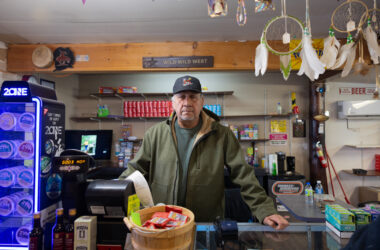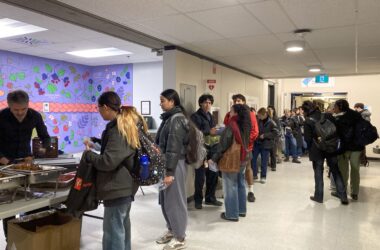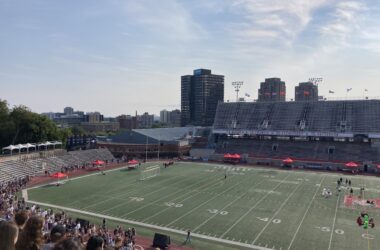 Sam Reynolds / McGill Tribune
Sam Reynolds / McGill Tribune Elisha Lerner / McGill Tribune
Elisha Lerner / McGill TribuneThe McGill student body is large and diverse, with a multitude of different interests that infrequently overlap. Rarely does an event on campus carry enough weight and importance to unite the entire school in discussion.
Thursday, Nov. 10 is an example of such an event. On that night, the occupation by 14 students of Principal Munroe-Blum’s office quickly devolved into something larger. Riot police were deployed onto McGill’s campus for the first time since 1969. Students—protesters and library-goers alike—were tear gassed, pepper sprayed, and by many accounts, hit, shoved, charged at, night-sticked, and intimidated by police in riot gear.
The sequence of events remains difficult to decipher. The administration has condemned the actions of the police but cites reports of intimidation and violence by the occupiers; a police representative denied any knowledge of the incident in a Nov. 11 interview with the Tribune. Occupiers claim security services initiated the use of force, and students cry “police brutality!”
When the administration publishes accounts of student violence and the occupiers are pointing at the security guards with masks (allegedly) clenched in occupiers’ upraised hands, the truth must be somewhere in between. This article is not intended to provide yet another account of exactly what happened on that night: McGill Dean of Law Daniel Jutras is conducting an independent inquiry, at the behest of the principal, that aims to do just that. An independent student inquiry is also in the works.
This article will instead examine a few of the issues surrounding the events of that evening. The following days and weeks have found groups on campus divided on many different levels: on the specifics of the occupation, on the decision to call the police, on expectations of what’s next. The Tribune takes a look at these different opinions point by point.
Police on campus
The events of Nov. 10 have been a source of ideological division among and within many groups on campus. However, a consensus has been reached by almost all of the McGill community on one issue: to use Principal Munroe-Blum’s own words, the presence of riot police on campus was “shocking.” However, the exact sequence of events leading up to the use of riot police is where disagreement occurs.
The reason behind the deployment of riot police on campus is unclear, though it was likely in response to the congregation of students around and in front of the James Administration Building. The riot squad was likely deployed by the police who were already dealing with the occupiers and the crowd around James Administration Building. Even this action has received mixed reactions from the McGill community.
Political science Professor Jacob Levy condemned the actions of the riot police, but attempted to explain—not excuse—the chain of events that led to their presence.
“It is true that the occupiers were there illegally and that it is legitimate for the university to use security to try and remove them,” Levy said in an interview with the Tribune. “And it’s also true that the protesters in support of the occupiers were moving in on the bicycle police in a way that really predictably triggers police looking for other police back up.”
“Clearly, the police handled the situation badly,” political science Professor Steve Saideman wrote on his blog, Saideman’s semi-spew. “Sending in the bike cops … was absolutely the wrong thing to do, as people tend not to take them very seriously.”
Calling in the police
Although the tactics of the Service de Police de la Ville de Montreal (SPVM) have been questioned, the decision to invite them onto campus has been the target of a debate more connected to broader issues on campus. It’s unclear what the university’s plan of action is when a protest turns violent and spirals out of control. However, anyone on campus has the authorization to call in the SPVM.
“[W]hen you call in the police, they don’t let you tell them how to do their job,” Principal Munroe-Blum said in an interview with the Tribune, the McGill Daily, and le Délit. “And I might add, as well: anyone can call the police. Anyone can pick up their cellphone and call [911].”
However, it remains unclear what contingecy plans exist between the police and the university once the SVPM are deployed.
“Hopefully, the investigation will reveal exactly what the position of the administration [is] when there’s something going on on campus: are they responsible for calling the cops?” said Prof. Saideman. “Do they actually have a chance to say no to the cops, or are they completely out of it? We have no idea who has what responsibility.”
Occupons McGill
What led to that phone call was a planned occupation of the principal’s office that quickly went off-book. Different accounts have surfaced since that evening: an anonymous letter from the 14 occupiers, some of whom have since come forward, and a letter from seven employees who were in the office at the time. Many groups and individuals at McGill have been throwing around terms such as “confrontational” and “masked,” clearly at odds with other accounts (“nonviolent,” “legitimate”).
“There are reports that some of the students’ faces were covered and I think that introduces a wholly different element to it,” Arash Abizadeh, a professor of political science, said in an interview with the Tribune. “I think there’s responsibility on a lot of different sides, depending on exactly what happened.”
Matthew Crawford, arts representative to the McGill Senate and a self-identified occupier, spoke about the debate surrounding the nature of the occupation.
“Three people went in with masks … as in a bandana covering just the lower half of their face … Once we were in, only one person kept on their mask,” he said. “One of the words that’s being bandied about is ‘overpowered’ … The idea of ‘overpower’ is so strong as a verb that it seems to conjure up this idea that we were pushing up against the door and knocking people over, which is not the case. We simply moved o
ur way in and used our bodies to block doors from people closing them on us.”
However, others believe that, masked or not, peaceful or not, the occupiers have some responsibility for what came next.
“I think that whatever they were doing inside the building, whatever their intentions were, they were making the situation more complex and potentially more violent,” Prof. Saideman said. “I think the best nonviolent protests are exactly that: nonviolent protests where you put the onus entirely on the other side, and part of the problem with doing it inside the building is it takes away the key advantage of the protest, which is the visibility of it all … I think that’s what the mistake was; you go into a building, and then it’s your word against theirs.”
Most can agree, however, that whatever processes were in place to deal with such an event were entirely unsuccessful on Nov. 10.
“What I think that this action serves to do is that it highlights an alienation between students and administration. They didn’t know how to deal with a peaceful protest; nobody in the office, not security, not the administration, clearly,” Crawford said. “This does not mean that they’re wrong about everything; it simply means that there is a disconnect—this is what we wanted to highlight through our occupation, although not through what happened [later].”
Professor Levy saw the devolution of control within the context of a broader movement across North America.
“If I’m the head of security at a university, and I see a student protest movement that explicitly links itself to the occupy movements … I’m more nervous than I would have been a month ago,” he said. “I think I’m probably quicker on the trigger—and I use that word deliberately.”
Looking forward
Beyond the policy or legal implications that any investigations may have, Abizadeh said that there is a “sort of moral responsibility of leadership … and I think that was what many of the faculty are hoping [the administration will address]—and we have good signs from the administration that they’re taking on that responsibility—so we’re hopeful.”
The inquiry’s results, to be released on Dec. 15, intend to address many of the questions raised by students, faculty, and administrators alike. An indepdent student inquiry will do the same, perhaps with different results.
“My concern is to make sure that the other [legal] processes are also put into place,” said Abizadeh.
“The proof is going to be in the pudding of ‘what does the university do?'” said Saideman. “That’ll probably be about the report, but it’s also going to be what’s not in the report … because you can have all the reports in the world but if you don’t change the behaviour, you don’t change the rules, you don’t change the training, you don’t change the doctrine, all that stuff, you’re just going to be repeating [what happened] down the road.”






